Where to see the last super-tusker elephants
A trailblazing new tented lodge in Kenya puts travellers within reach of a rare safari sighting: the last of the African elephants known as “super-tuskers”.
Like seasoned hosts, a convivial herd of elephants wanders out of the brush just minutes after our charter plane touches down at a private airfield in southern Kenya. Kimana, an area triangulated by three national parks – Amboseli, Chyulu Hills and Mount Kilimanjaro – is akin to a pachyderm paradise, so this is a fitting welcome party. In fact, this area is trumpeted as one of the best places to see Earth’s largest land mammals meandering across a tapestry of habitats. It’s also home to the most majestic elephants of all: “super-tuskers” – bulls with incisors so colossal, heavy and long that they often scrape the ground.
Within the Amboseli ecosystem that straddles southern Kenya and northern Tanzania, only about 10 of these large-tusked elephants remain in the wild, and we’re determined to see one. Our destination, the tented lodge of Angama Amboseli, is a chicly comfortable launching pad for doing just that. Opened in November last year, the camp is the latest project from Nicky and the late Steve Fitzgerald (andBeyond alums who have helmed dozens of the finest lodges in Africa). In 2015, the pair debuted Maasai Mara-based Angama Mara, whose clean-lined design and resort-style amenities were deemed a game-changer on the continent. Angama Amboseli is a significant second act with the same emphasis on style and service, as well as a foray into conservation. The choice of Kimana Sanctuary for its 10 suites grants guests exclusive access to a 2300-hectare wildlife corridor (Nicky Fitzgerald was impressed with the location while flying over it in a light aircraft). With no other jeeps jockeying for sightings here, guests have the sanctuary and its resident wildlife entirely to themselves. In partnership with the Big Life Foundation, a nonprofit that helps manage the community-owned sanctuary, the resort plays a vital and vigorous role in protecting centuries-old elephant stamping grounds.
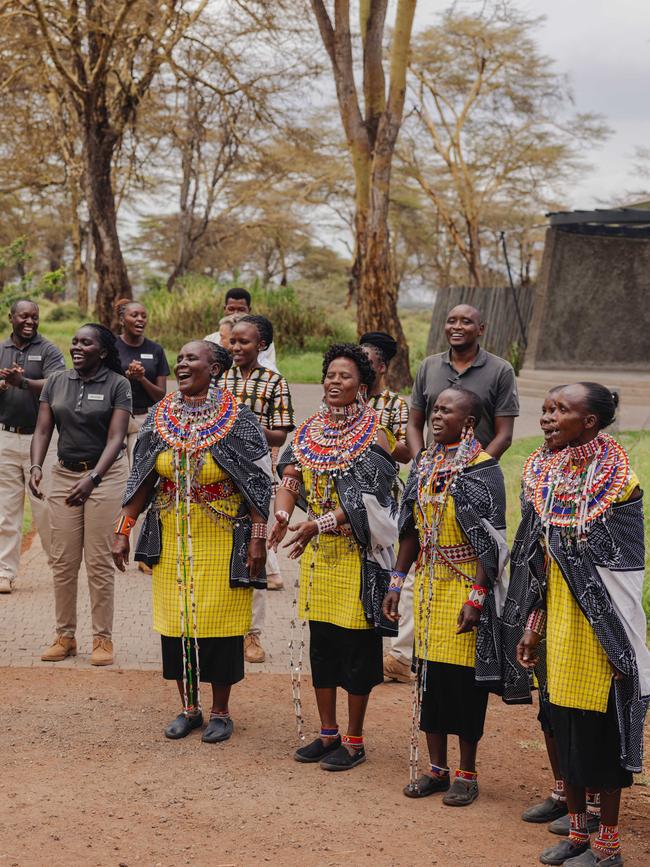
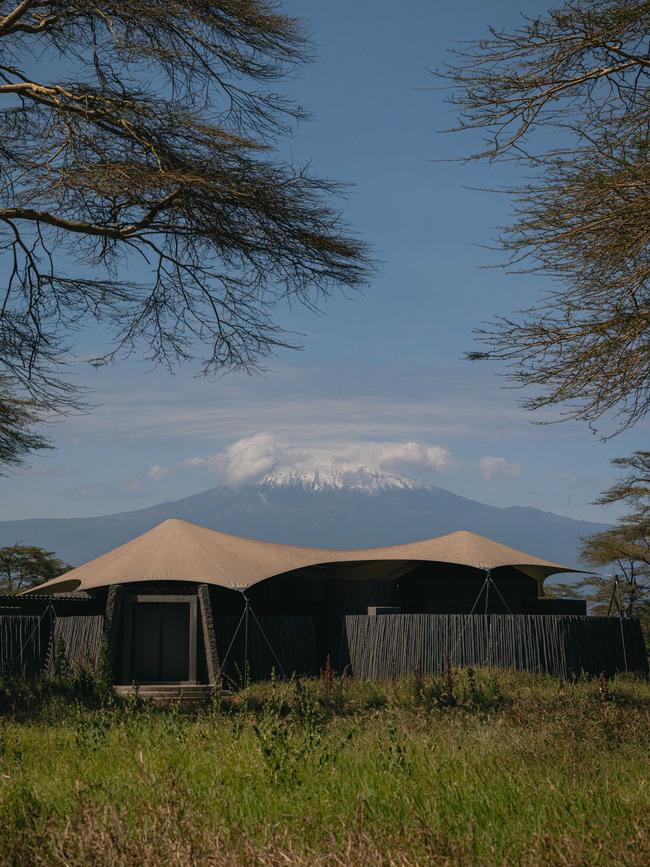
-
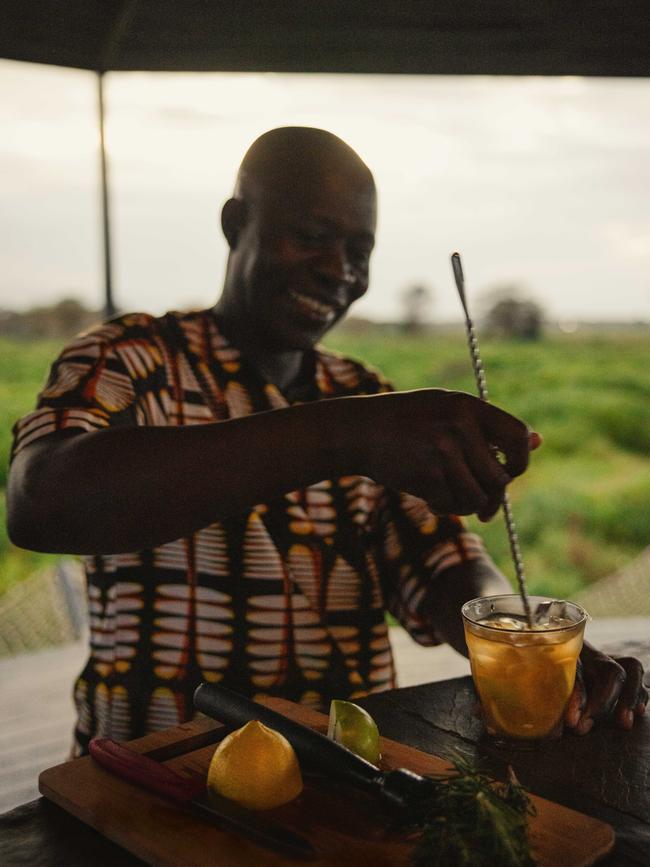
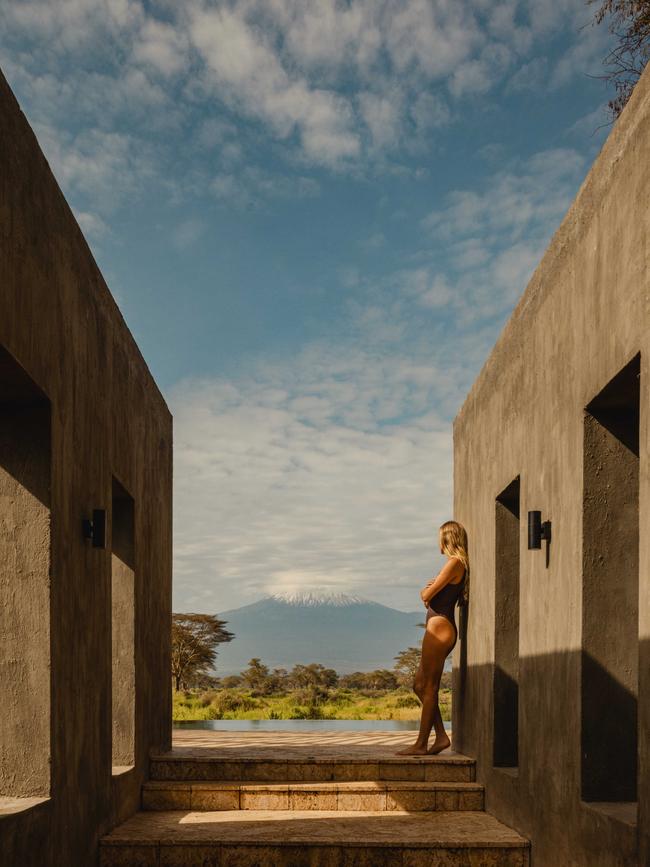
Even its distinctive design, by architect Jan Allan and designer Annemarie Meintjes, pays homage to the star residents. Squint, and the tented rooflines of the suites appear like modern renderings of elephants, while the gently curved walls and terraces of the common spaces nod to the shapes of the animal’s backs and ears. Meanwhile, elephant dung adds texture to adobe-style surfaces. Elephant photographs preside over the dining area, and an elevated pool includes a drinking trough below to attract them (and other creatures, too). Near the entrance, replica tusks of Tolstoy, a mainstay of the sanctuary until his death in 2022, are on display. These ivory incisors are immense: the one I run my hand down measures more than 250 centimetres. Together, they weigh almost 113 kilograms.
Much as we’re excited to seek out super-tuskers, exploring our suite is an adventure in itself. I’m visiting with my husband, our two young children and another family of four. When we arranged our trip through boutique safari designer Your Private Africa, securing the lodge’s pair of family suites was pivotal – and they didn’t disappoint. Each suite has two well-appointed bedrooms, connected by a passage. This walkway could have been utilitarian, but sunlight slips through the slatted ceiling in a dramatic striated effect. King-sized beds face Mount Kilimanjaro, while the spacious bathrooms are equipped with an Antonio Lupi-designed shower head light that cheerfully winks on. Thoughtful touches include an armoire kitted out with house-made snacks and decanted gin and whisky, pre-stamped postcards on the desk, and a painting set complete with smock. A butler is assigned to each suite to attend to every comfort.
I spy Meintjes strolling past the lodge’s studio – which offers lens rentals, printing services, tutorials and the ability to hire a private photographer – and I can’t help but pepper her with questions about the bold interiors. She shares a mood board’s-worth of references: the influential designs of Chanel and Stelton in the 1960s, accent colours of coral and lime, the earthy shades of the landscape and the elephant’s form. A traditional, dark, and Out of Africa-like lodge Angama is not, and it’s wildly refreshing. In the dining pavilion is a chartreuse sofa, its curvaceous back inspired by an acacia leaf, Meintjes notes. Facing the grounds, it’s an ideal perch to savour a Dawa, “medicine” in Swahili, a concoction of tangy-sweet lime, honey and vodka. The night ends with a twilight drive through the sanctuary, where foxes, hyenas and, of course, elephants appear as the stars twinkle overhead.
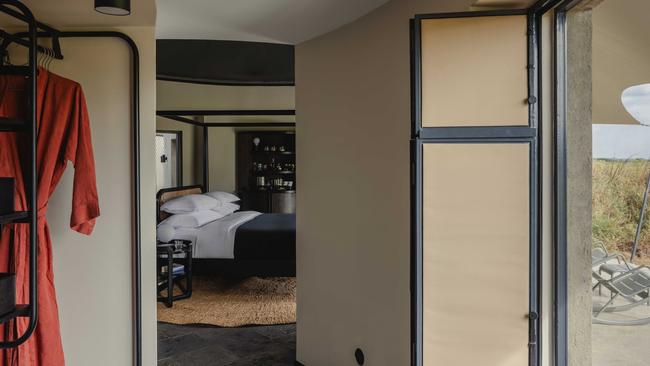
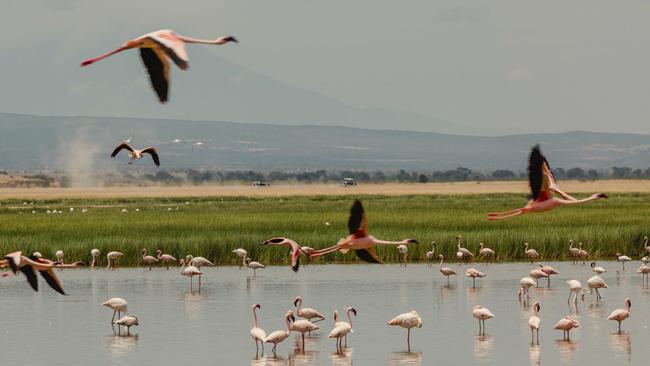
As the next day dawns, our group quickly realises it’s not only super-tuskers we’re excited to view – it’s Kili, too. So far, the famous mountain has been fully shrouded by clouds. “She’s shy sometimes,” says camp host George Neto, “but she’ll show herself.” When the peak is visible, the nearby giant can be glimpsed from nearly every angle of the camp, including, apparently, our suite’s indoor shower. There’s no time to verify that right now, though – our game drive awaits.
Amboseli National Park may lack the name recognition of the Maasai Mara, but with such a splendid array of wildlife and a varied landscape, perhaps it shouldn’t. Within minutes, a lilac-breasted roller, Kenya’s national bird, bursts from a tree as we roll across grassy plains. Giraffes, zebras and wildebeests soon appear, too. Elephants, some 1800 of which call the area home, amble in long solemn lines through the marshes. And Lake Amboseli itself, polka-dotted with flamingos, storks, spoonbills and more, sets an idyllic scene. We pause to watch a ferocious scuffle between two wildebeests and to take in the sight of elephants flinging terracotta-hued dust across their bodies to cool down.
As impressive as these sights are, super-tuskers remain elusive. Back at Angama, we ask guide Johnson Salaash to tap his network for intel on one in particular: Craig, a 51-year-old bull, who is currently the oldest, largest and most well-known of his kind. He’s regularly tracked, but often ranges into areas difficult to access. When word comes back the next day that he’s been spotted, we head straight out. About 30 minutes of off-roading through moderately heavy brush yields our considerable prize – an audience with Craig himself. His body is roughly the size of our jeep, with one tusk so lengthy that it, indeed, sometimes reaches the ground. We trail him for about an hour, awed by his presence, as he peacefully munches shrubs and grasses.
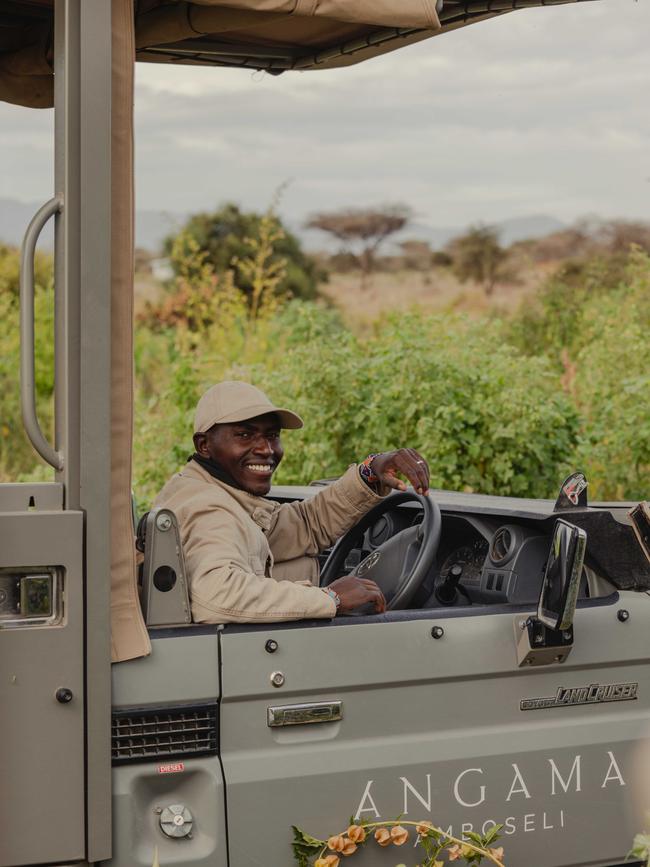
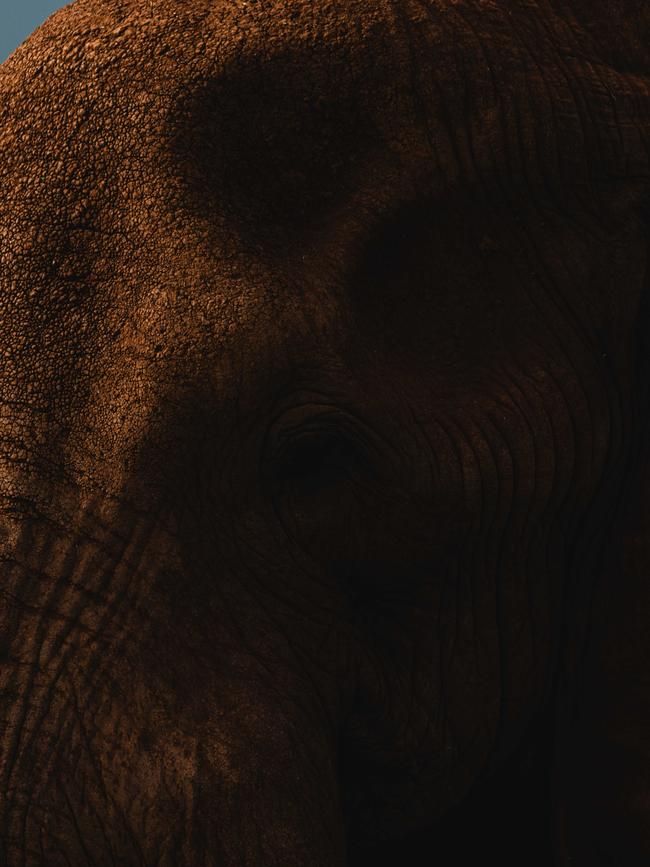
-
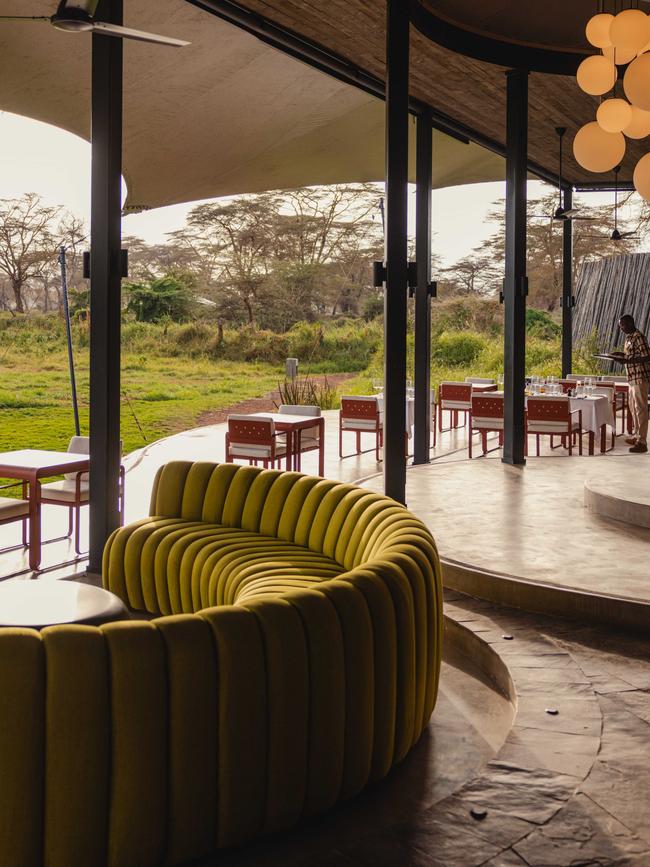
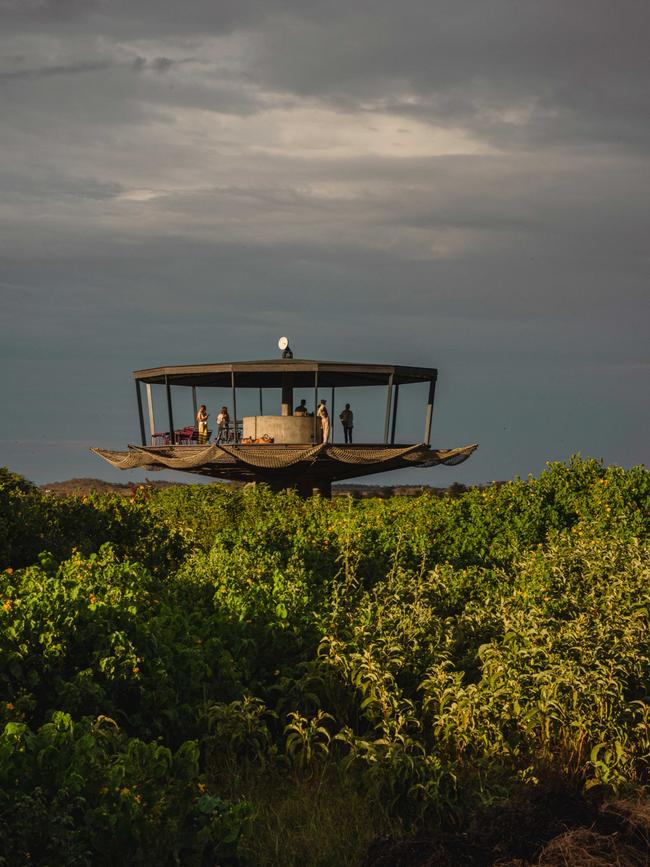
It’s possible that encounters like this might fade into the history books. Massive elephant ivories are due to genes, but over the years such genetically blessed individuals have been targeted by poachers. So few survivors remain to breed that some researchers worry super-tuskers may even disappear within two to three years. And while poaching hasn’t been a problem in this part of Kenya for close to a decade, long-tusked elephants are still in danger if they wander across the Tanzanian border; three super-tuskers were recently legally trophy-hunted, one as recently as March, leading to outcries for better cross-border protections. Farmers, too, may injure or kill elephants who range through their properties. “Ellies love tomatoes,” says Salaash as we head to the camp’s mnara, an observation tower north-west of the guest area. He sometimes finds rogue vines around the sanctuary, likely grown from seeds deposited in an elephant’s dung after it trespassed through a garden.
At the top of the tower, a sense of wonder sets in again as the landscape unfurls. While Mount Kilimanjaro remains hidden, the sunset paints the dusty green plains gold and purple as we nibble from silver boxes replete with charcuterie, including local biltong, cheese, nuts, and olives. Dinner, served privately to our group in the camp’s candlelit art gallery while the children relish a nearby playroom, brings courses of freshly baked bread, salads of produce grown on site, and expertly prepared pasta, chicken and more, all paired with South African wines. Toasts are given in Craig’s name, and to the endurance of super-tuskers, which, unthreatened, can live to between 60 and 70 years of age.
Our final morning brings an early surprise: Kili’s snow-capped summit suddenly bursts from the clouds, setting off a flurry of texts and wake-up calls between our suites (and I can now attest that the mountain is visible from the shower). Cameras in hand, we all dash to the lodge’s infinity pool to see the peak reflected in the water, and to swim in what might be the most aesthetically pleasing pool in Kenya. The peak stays visible for about 40 minutes before it’s again engulfed by the mist. Which is just as well, since it’s time to leave. Before we do, I stop by the camp’s boutique, choosing a locally made silver elephant ring. Its selection, I decide, is in honour of Craig. A straight-on rendering of an elephant’s head, it features a trunk playfully curled to one side, exposing a lengthy tusk – a reminder of how something wholly natural can also be so precious.
The writer was a guest of Angama Amboseli. Daily rates start at around $2,700 per person. angama.com

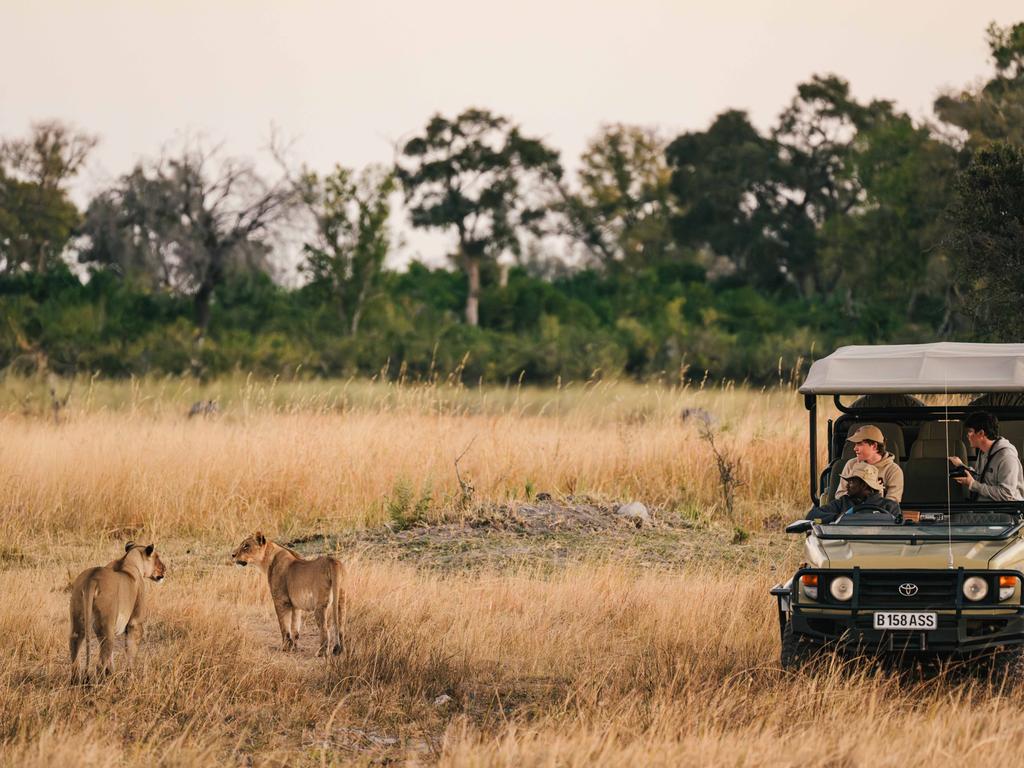

To join the conversation, please log in. Don't have an account? Register
Join the conversation, you are commenting as Logout